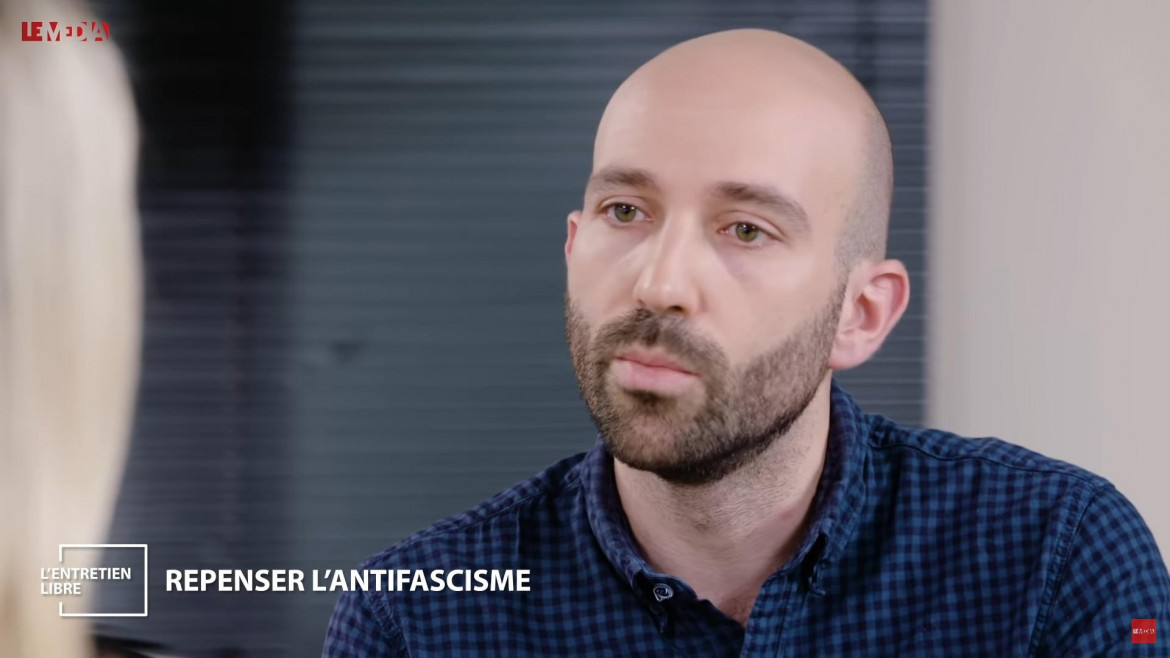written by Filippo Ortona

Interview. We interviewed the French sociologist and editor of Contretemps, Ugo Palheta. ‘We are at an intermediate moment in which political power is weakened by social opposition, yet still strong enough to move forward.’
Location
PARIS
Published on
May 3, 2023
Ugo Palheta is a French sociologist and researcher at the University of Lille. Founder of the journal Contretemps, he specializes in the study of inequality and in recent years has been working on the connections between neo-fascism and neoliberal policies.
In 2018 he published La possibilité du fascisme: France, la trajectoire du désastre (ed. La Découverte).
Emmanuel Macron is embroiled in an unprecedented crisis in France. Paradoxically, the more the crisis deepens, the more unlikely it seems that he will take a step back on pension reform. How can this contradiction be explained?
There is a deep crisis of the legitimacy of neoliberal policies, which had its origins long ago, but which has reached a climax during Macron’s term. His entire presidency has been marked by very strong mobilizations: the movement against François Hollande’s Loi Travail (for whom Macron served as economy minister), the gilets jaunes, the 2019 strikes against the previous attempt at pension reform, the refineries, the hospitals, the anti-racist and feminist movements – and, today, this social movement of historic breadth.
The neoliberal project seems to have reached that moment that Gramsci characterized as domination without hegemony: it now stands due to repressive coercion on the one hand and the weakness of the political left and the social movement on the other. The latter is strong enough to cause major shocks to any attempt to impose neoliberal reforms, but too weak to achieve their effective abandonment – not to mention the dissolution of Parliament or Macron’s resignation.
We are at an intermediate moment in which political power is weakened by social opposition, yet still strong enough to move forward. Nonetheless, the issue is now on the table, on the movement’s agenda: the legitimacy of the constitution of the Fifth Republic, its authoritarian and Bonapartist character.
The top-heavy character of the Fifth Republic is one of the central themes being challenged. Why did Macron choose to stretch the mechanisms of the French Constitution so far to the extreme?
The constitution of the Fifth Republic takes some liberties from democratic standards in this direction, being a fundamentally Bonapartist text that gives unbridled power to the executive. Since its implementation in 1958, France has never been a normal liberal democracy of the kind we are used to in the West.
The other, more general aspect is the moment that capitalism is undergoing: the marriage between democracy and capitalism was a temporary phenomenon. This marriage was based on the union of formal freedoms and social democracy, on the limitation (even if minimal) of exploitation and the guarantee of growth rates for capital: the legitimacy of the system lay at the intersection of these factors. That balance came into crisis decades ago, and we are still living within this long crisis of capitalism. The imposition of the European Constitution in 2005, against the referendum vote where the French rejected it, or the dismal fate reserved for Syriza in 2015, are examples of how capital now tends to emancipate itself from democracy: first and foremost from social democracy, but at this point also from political democracy, as we’re seeing in France.
The French crisis is due to this intersection between the country’s institutional history and the long crisis of capitalism, which is tending towards emancipating itself from democratic mechanisms.
In recent weeks, a series of polls have shown a growth in support for Marine Le Pen’s far-right. How is this possible, given the total absence of the Rassemblement National (RN) from the social movement?
One reason is that the polls are taken at a time when most people think that this social movement has little chance of winning the pension battle. For this struggle to produce the greatest possible effect for the left in electoral terms, it would have to result in a victory. But there is another aspect: the far right today provides a “reasonable” continuity to neoliberal policies. The “radical break” left, on the other hand, appears to many people as something risky. A policy of a break with neoliberalism in France could trigger a counteroffensive of capital, as happened in Greece or South America – and people are taking this into account.
In contrast, the far right offers a form of continuity: what Le Pen proposes is not a break with neoliberalism, but a version of it presented as more reasonable, which would continue some policies while intensifying others. This is true on the issue of security, where the RN’s program is entirely compatible with the racist evolution of French politics in recent decades, but it’s especially true on economic policy. For example, on pensions, Marine Le Pen proposes up to 43 years of contributions and retirement at age 60 only for those who started working before the age of 20: basically, a slightly more moderate version of Macron’s reform.
What differentiates Macron from the far right, as you’re saying the latter is in continuity with the current government?
The political area of discourse of the French far right is that of the Nation Threatened by Enemies, internal and external. This is what it builds its discourse on, its attempt at hegemony. If it comes to power, it will continue the neoliberal reforms, also adding a policy of repression against social movements and trade unions – a model similar to that put into practice by Orbán in Hungary, a kind of ordonationalism. In doing so, it could restore legitimacy to the neoliberal project, under the auspices of increasingly xenophobic policies and through the systematic construction of the figure of the Enemy Within: be it the trade unions, the social movements, ecologists, immigrants, etc. Unlike Macron, Le Pen’s electoral base doesn’t limit her at all in this regard: she will be able to go all the way in this process, built on a mixture of reactionary nationalism and neoliberal policies that are violent in content as well as in form.





